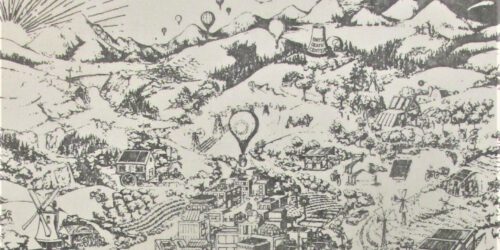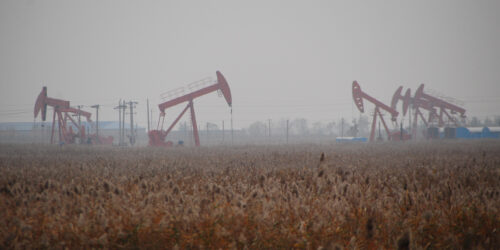A Near and Arid Future: Barbara Sapergia’s novel, Dry

This post by Merle Massie originally appeared as part of a series on Environmental Histories of the Future on NiCHE, the Network in Canadian History & Environment.
I first read Barbara Sapergia’s novel Dry in 2007, just over a year after its publication by Coteau Books in 2005. At the time, Saskatchewan was into the third year of what turned out to be a series of very wet years on the prairies, starting with the legendary floods of 2005 where places like Cumberland House in the Saskatchewan River Delta had to be evacuated.

A novel about drought—a culture-changing, severe, prolonged drought due to climate change—didn’t resonate in its publication year or for years after in the way it perhaps could have, had it been published just a few years before in, say, 2000, when Saskatchewan was suffering for rain. There’s a certain built-in trenchant believability that underscores a drought novel if you’re reading it during a prairie dust storm.
That’s what makes Sapergia’s novel an even better read for me now, in the winter and spring of 2021 when the land is once again crying out for moisture and farmers are seeding into dust.
Sapergia, one of Saskatchewan’s more celebrated local authors, offered her novel Dry as a retelling of the prairie dirty thirties mythology of drought and decimation through the lens of a dystopian future. A quiet review of this novel seemed a perfect addition to the NiCHE call for Environmental Histories of the Future, which asked (among other things) for writers to look for “Representations or imaginings of the environmental future in fiction, film, and art” (for other great posts on perceptions of environment in post-apocalyptic literature in this series, see e.g. Trang Drang’s “Of Monsters and Hope” and Elliot Honeybun-Arnolda and Reuben Martens’ “Tedium, Tins, and Turbines: Sleepwalking in Doggerland”).

Saskatchewan writers have a long history of creating stories based on Saskatchewan’s past, and some of its most lauded fiction, such as Sinclair Ross’ works As for Me and My House or The Lamp at Noon (and other stories) pull directly from the iconic images of that time when Saskatchewan nearly died, drowned in dust. Sapergia drew on those dirty thirties images, but instead sent her mind forward into the future, imagining how Saskatchewan might respond to the real risk of climate change-induced drought and despair.
The book opens in 2023, and we meet the main character, Signy Nilsson, as she’s speeding in her hovercraft across the southern prairie, from Roche Percee across the barren desiccated and burned-out landscape to the oasis of Moose Jaw. Regina is a ghost town; the provincial legislature building has been moved, stone by stone, north to La Ronge, where water still runs in the Churchill River system. Signy’s hovercraft, at one point, has to land and wait out a dust storm, roiling and raging around her. It’s the dirty thirties, but in 2023.
The novel’s recognizable spaces, to those from the prairies, offers not reassurance to the reader, but discomfort. It’s familiar, but it’s clearly changed. The drought, we learn, hit hard, then leaned in harder. Even so, Saskatchewan knowledge from the dirty thirties rings through Sapergia: some places got hit harder by the drought than others, and the provincial north remained less touched, the new oasis. My own PhD research, which brought forth Forest Prairie Edge, balanced this geographic seesaw of arid south and lush north.[1] Sapergia plays the northern card, then focuses the novel’s energy on fixing what’s so clearly broken: the prairie south.
The arc and driving force of Dry is farming and agricultural research, finding a way to bring the land back to life. Signy lives northeast of Saskatoon with her brother, where they run Sunterra Farm, along with her son David, who is deaf. They are a small research farm, dwarfed and surrounded by their neighbour, Magnus Dragland, who is the villain of the novel. Dragland is determined to force them out, take over their farm and hold unbroken ownership for miles in every direction.
The plot ricochets between Dragland on the one hand, depicted as an un-aging vampire-like character well beyond normal human years, doggedly farming with conventional agriculture. On the other, Signy and her brother pride themselves on their quarter section of unbroken prairie and accompanying organic farmed acreage. Antagonism between the two farming cultures (conventional and organic) is mirrored and reflected in the characters.
The Nilsson siblings are on the cusp of a wondrous agricultural discovery: at their farm, and at satellite research plots at the Wrekker colonies near Regina and Nipawin (where communities grew up using the wrecked debris of useless equipment), they are growing plots of Sunterra Gold—a genetic cross between prairie wheat and perennial native prairie grass.
Sapergia picks up on a dream long held, but never realized within western Canadian agriculture: cross-breeding or otherwise creating a native perennial plant with roots deep enough to withstand multi-year droughts but offering crop-level wheat production every fall, with no annual reseeding of crop or tillage required.[2] Science drives much of the novel’s plot, and we meet other university researchers, including adversaries who also want Signy’s science secrets. As a farmer, I have questions. My agronomist husband has many more. This cross has never yet been commercially accomplished, though it remains on modern researchers’ radar. But this is a novel, and we’re allowed to dream and imagine and set aside the limitations of biology and science, and write about hope.
Overlaying the plot of drought and ecosystem-saving agricultural research is a secondary revenge plot between Dragland and the Nilsson family. Dragland had once been deeply in love with Signy’s great-grandmother, who spurned his hand to marry another. The pain of that rejection echoes through every page, spurring Dragland’s insatiable anger and thirst for revenge, to eradicate the Nilssons and erase their farm.
From a purely stylistic point of view, the novel has great flow and imagery. The characters have history and secrets, and Signy’s son David has a touch of mystical power that allows him to take up a different space than a regular 12 year-old boy. It holds space for First Nations characters with depth, insight and power—they are partners in the work of Sunterra Gold and stand ready to be part of its rollout to bring life back to the plains. These characters and their involvement makes Dry more than a settler story; it’s about regeneration of a biome, with all its inhabitants saved and given a new, better future.
Where the novel creaks and groans is in its futurism. It’s too futuristic for 2023—hovercrafts and a decimated climactic landscape, with Wrekker colonies and social upheaval of the magnitude described—would be more believable had it been set in, say 2050, or 2080. 2023 looms straight ahead. That kind of social overhaul takes more time than what Sapergia allowed, publishing in 2005. My inability to really sink myself into this novel could have been fixed in the editing process by changing the dates, and that’s a bit of a shame. And, I don’t have a hovercraft. I’m jealous.

If you’re looking for a short Canadian novel that engages with ideas of climate change, natural and scientific solutions, drought and desiccation, social relocation and renewal, all strung along recognizable spaces, then consider adding Dry to your reading lists. And its best audience might be right here in western Canada, with students from the very spaces noted in the book, seeing their near and arid future writ across the page. It would be a compelling starting point to guide discussion around the question: well, what if the scientists are right, and the next multi-year and even wholescale culturally-changing drought is right around the corner? What, exactly, would Saskatchewan do? That kind of blue-sky literary discussion might ease recalcitrant and combatant voices which now may scoff heavily at the idea that the climate is changing—even as we farmers, with hearts in our throats, seed into dust.
Dry is a little-known Saskatchewan literary gem that, even with its few drawbacks, offers a positive and hopeful depiction about how humans might, in truth, try to address looming climate and cultural disaster while finding a way to creatively and caringly stay rooted in place. Because it’s Saskatchewan. And the characters would rather endure it and fix it, than leave.
[1] Merle Massie, Forest Prairie Edge: Place History in Saskatchewan (Winnipeg: University of Manitoba Press, 2014).
[2] Lei Cui et al., “Development of Perennial Wheat Through Hybridization Between Wheat and Wheatgrasses: A Review,” Engineering 4, no. 4 (August 2018): 507-513.






Was simply looking for the title of Barbara’s book and found this. I loved the book and may reread it this fall.